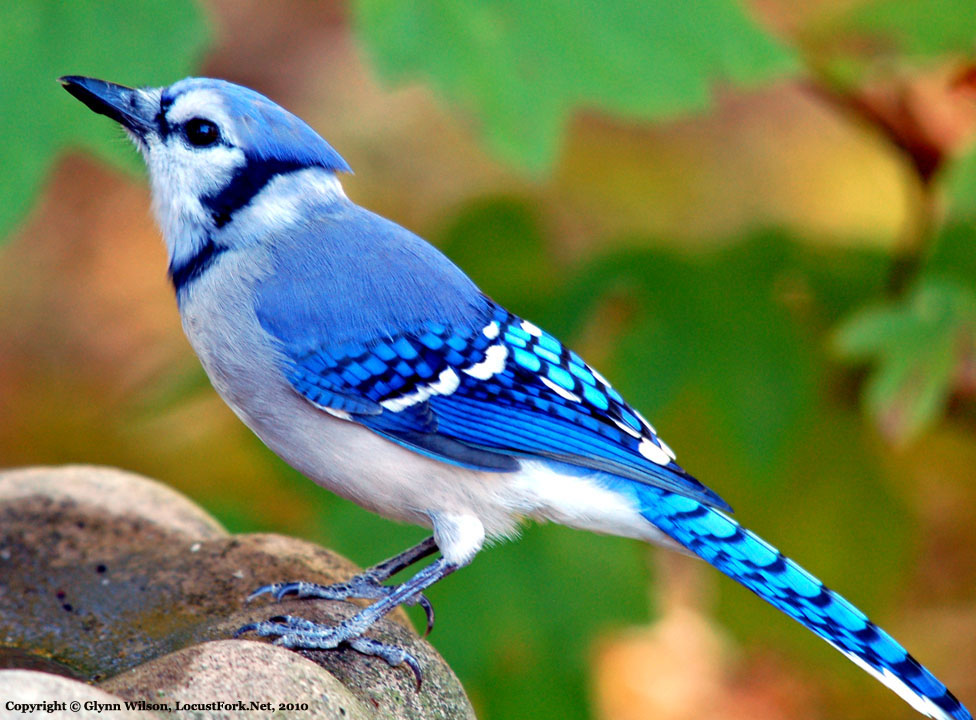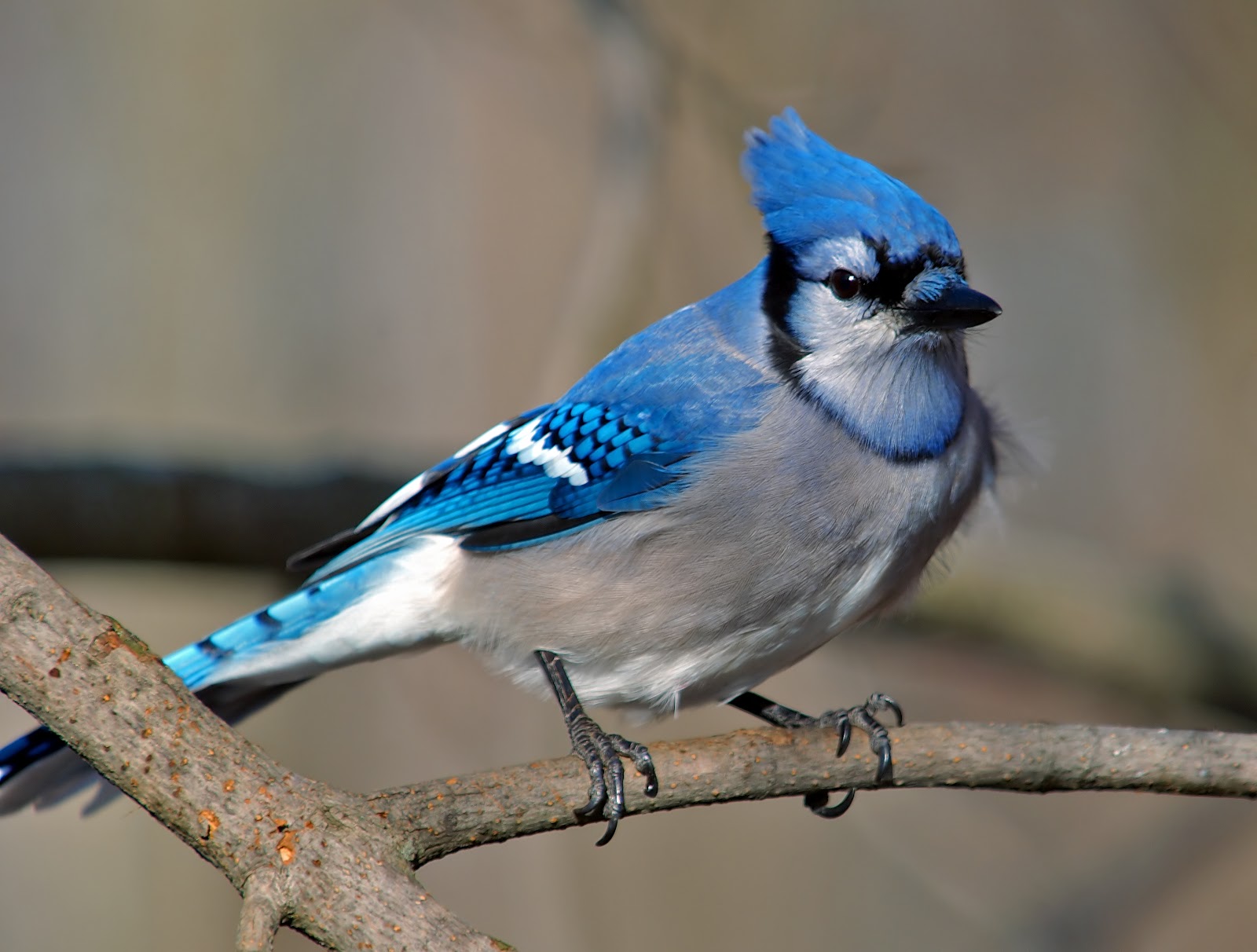Blue Jays in Nature

The blue jay, a common and charismatic bird found throughout North America, is a captivating creature that embodies the beauty and diversity of the natural world. Its striking plumage, intelligence, and unique behaviors make it a fascinating subject for observation and study.
Physical Characteristics
The blue jay’s most distinctive feature is its vibrant blue plumage, which covers its wings, back, and tail. Its head is black, with a white band across the forehead and a black “mask” around the eyes. This striking combination of colors makes the blue jay easily recognizable. Its underside is white, with a hint of pale blue on the breast. The blue jay’s wings are relatively long and pointed, giving it a graceful flight pattern. It also has a short, stout beak that is ideal for cracking seeds and nuts.
Habitat Preferences
Blue jays are adaptable birds that can thrive in a variety of habitats, including forests, woodlands, parks, and even urban areas. They are particularly fond of mature deciduous forests, where they can find abundant food sources and nesting sites. However, they are also commonly found in suburban backyards and city parks, where they have learned to exploit the resources provided by humans.
Diet
Blue jays are omnivorous birds, meaning they consume a wide range of food items. Their diet includes acorns, nuts, seeds, fruits, insects, and even small vertebrates. They are particularly fond of acorns, which they often cache for later consumption. This behavior helps to disperse oak trees, as the blue jays often forget where they have buried their acorns, allowing them to sprout and grow into new trees.
Breeding Behavior
Blue jays are monogamous birds that form strong pair bonds. They typically breed in the spring, building their nests in tree cavities, abandoned woodpecker holes, or dense foliage. The female lays 3-7 eggs, which are incubated for about 18 days. Both parents share the responsibility of incubating the eggs and feeding the chicks. The chicks are altricial, meaning they are born helpless and require constant care.
Social Interactions
Blue jays are highly social birds that live in complex social groups. They communicate with each other using a variety of vocalizations, including calls, whistles, and songs. These calls are used to signal danger, attract mates, and maintain social order within the flock. Blue jays are also known for their territorial behavior, defending their territories from rivals. They are often seen chasing away other birds, squirrels, and even humans that they perceive as threats.
Blue Jays in Culture

The blue jay, with its striking plumage and boisterous call, has captured the imagination of people across cultures for centuries. From its portrayal in art and literature to its role in folklore and mythology, the blue jay has earned a place in the cultural landscape, often symbolizing themes of intelligence, adaptability, and even mischief.
The Blue Jay’s Symbolism
The blue jay’s symbolism varies across cultures, reflecting different beliefs and values. In some cultures, the blue jay is seen as a symbol of good luck and prosperity, while in others, it is associated with trickery and deception. The blue jay’s intelligence and adaptability are often reflected in its symbolism, with some cultures associating it with wisdom and foresight.
The Blue Jay in Folklore and Legends
The blue jay’s role in folklore and legends is rich and diverse. In Native American cultures, the blue jay is often associated with trickster figures, embodying both cunning and wisdom. The Cherokee people, for example, believe that the blue jay was responsible for bringing fire to humans. In other cultures, the blue jay is seen as a messenger of the gods or a guardian spirit.
The Blue Jay’s Cultural Impact
The blue jay’s cultural impact can be seen in its influence on art, music, and literature. The bird’s vibrant plumage has inspired artists, while its distinctive call has been incorporated into musical compositions. In literature, the blue jay has been used as a symbol of various themes, from freedom and independence to intelligence and adaptability.
Cultural Significance of the Blue Jay, Blue jays
| Region/Culture | Symbolism | Folklore | Artistic Representation |
|---|---|---|---|
| Native American Cultures | Trickster figure, messenger of the gods, guardian spirit | Stories about the blue jay bringing fire to humans, mediating disputes, and teaching lessons | Depicted in beadwork, pottery, and other traditional art forms |
| European Cultures | Intelligence, adaptability, mischief | Legends about the blue jay’s ability to mimic human speech and its association with the devil | Featured in paintings, poetry, and literature |
| Eastern Cultures | Good luck, prosperity, wisdom | Stories about the blue jay as a symbol of harmony and balance | Depicted in traditional art forms, such as calligraphy and woodblock printing |
Blue Jays in Science

The blue jay, a vibrant and intelligent bird, plays a crucial role in the intricate web of life. Its impact on the ecosystem, migratory patterns, and cognitive abilities have captivated scientists for decades, revealing fascinating insights into the natural world.
Ecosystem Role
Blue jays are integral to the health and balance of their ecosystems. They are omnivores, consuming a diverse diet that includes seeds, nuts, fruits, insects, and even small vertebrates. Their seed dispersal activities contribute significantly to forest regeneration. Blue jays cache, or hide, seeds in various locations, often forgetting about them, which allows these seeds to germinate and establish new plants. This process enhances plant diversity and helps maintain healthy forest ecosystems. They also play a vital role in controlling insect populations, particularly caterpillars, which they consume in large quantities. This natural pest control helps protect trees and other plants from damage. In predator-prey relationships, blue jays are both predators and prey. They prey on insects, small mammals, and reptiles, while also being vulnerable to predators like hawks, owls, and snakes. This dynamic interplay contributes to the overall stability of the ecosystem.
Migratory Patterns
Blue jays exhibit a fascinating migratory behavior, influenced by factors like food availability, weather conditions, and breeding cycles. They are considered partial migrants, meaning that only some populations migrate, while others remain in their breeding territories year-round. The migratory patterns vary depending on the geographic location. For example, blue jays in northern regions tend to migrate further south during the winter months, seeking warmer climates and food sources. The migration patterns are influenced by the availability of food, with blue jays moving to areas with abundant acorns, nuts, and other food sources. Their ability to adapt to changing environmental conditions, including seasonal changes, highlights their resilience and adaptability.
Intelligence and Cognitive Abilities
Blue jays are renowned for their intelligence and cognitive abilities, which have been the subject of extensive scientific research. Studies have revealed that blue jays possess remarkable problem-solving skills, memory, and communication abilities. They are known to solve complex puzzles, such as retrieving food from hidden compartments or navigating mazes. Their spatial memory is exceptional, enabling them to remember the locations of their food caches, even after long periods. This ability is crucial for their survival, allowing them to retrieve food during times of scarcity.
Vocalizations and Communication
Blue jays have a diverse repertoire of vocalizations, including calls, songs, and mimicry, which they use to communicate with each other. Their vocalizations play a vital role in social interactions, territorial defense, and alarm calls.
A study investigating the blue jay’s vocalizations could be designed as follows:
- Objective: To investigate the different calls used by blue jays and their meanings in communication.
- Methods:
- Record blue jay vocalizations in their natural habitat using audio recording equipment.
- Analyze the recordings to identify different call types, such as alarm calls, contact calls, and territorial calls.
- Observe the blue jays’ behavior during the recordings to correlate specific calls with specific actions or events.
- Compare the call types and their meanings to those of other bird species.
- Expected Results: The study is expected to identify and categorize the different calls used by blue jays, revealing their meanings in communication. This information will contribute to our understanding of blue jay social interactions, territorial behavior, and alarm signaling.
Scientific Understanding of Blue Jays
| Year | Discovery/Advancement | Significance |
|---|---|---|
| 1800s | Early descriptions and classifications of blue jays | Established the blue jay as a distinct species and laid the foundation for future research. |
| 1900s | Studies on blue jay behavior, including their feeding habits, nesting, and territoriality | Enhanced our understanding of blue jay ecology and social interactions. |
| 1950s-1960s | Research on blue jay vocalizations and communication | Revealed the complexity of blue jay communication and the role of vocalizations in social interactions. |
| 1970s-present | Extensive studies on blue jay intelligence and cognitive abilities | Demonstrated the remarkable problem-solving skills, memory, and communication abilities of blue jays. |
Blue jays – The blue jay, a vibrant flash of azure and black, is a familiar sight in the eastern forests, its raucous call echoing through the trees. But even the most spirited blue jay might pause in its pursuit of acorns if it witnessed the fierce rivalry of the marlins vs phillies , a battle for supremacy that unfolds on the diamond, a spectacle of athletic prowess and strategic brilliance.
And just as the blue jay fiercely defends its territory, these teams fight for every inch of the field, leaving no doubt of their dedication to victory.
Blue jays, with their vibrant plumage and boisterous calls, are a common sight in North American woodlands. Their sharp intellect and fearless nature make them a fascinating study, and their athleticism is on par with some of the most powerful athletes on the planet.
Just as a blue jay can soar through the air with breathtaking grace, giancarlo stanton can unleash a thunderous blast that sends baseballs flying into the stratosphere. The power and precision of both the blue jay and Stanton are a testament to the remarkable abilities found in nature and the world of sport.
